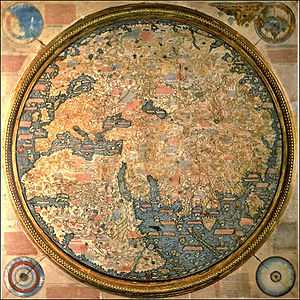Fra Mauro

Fra Mauro, O.S.B. Cam., (died 1460) was a 15th-century Camaldolese monk who lived in the Republic of Venice. He was a monk of the Monastery of St. Michael, located on the island of Murano in the Venetian Lagoon. It was there that he maintained a cartography workshop.
In his youth, Mauro had traveled extensively as a merchant and a soldier. He was familiar with the Middle East. He entered monastic life at a late stage in life. In the monastery, he became a mapmaker. Although he was no longer free to travel, due to his religious status, he would frequently consult with merchants of the city upon their return from overseas voyages. By 1450 he composed a great mappamundi (world map) of the Old World with surprising accuracy, including extensive written comments reflecting the geographic knowledge of his time. The map is known today as the "Fra Mauro map". A critical edition of the map was edited by Piero Falchetta in 2006.
The 1459 map

Fra Mauro created this map under a commission by King Afonso V of Portugal. Andrea Bianco, a sailor-cartographer, is recorded as having collaborated with Fra Mauro in creating the map, as payments made to him between 1448 and 1459 testify. The map was completed on 24 April 1459, and sent to Portugal, but didn't survive. Along with the map was a letter from the Doge of Venice. It was intended for Prince Henry the Navigator, Afonso V's uncle. It encouraged the prince to continue funding exploratory journeys. Fra Mauro died the following year, while he was making a copy of the map for the Signoria of Venice. The copy was completed by Andrea Bianco. A commemorative medal of the period struck in honor of his cartographic work describes Fra Mauro as "chosmographus incomparabilis".
The map of the Venetian Monk Fra Mauro, closely resembles that of the famous cartographer and geographer Al-Idrisi of Palermo.
Far East
The Fra Mauro world map shows influences from Chinese geography, which can be traced to the information supplied by fellow-Venetian Niccolò Da Conti.[1] These influences seem to include mistakes, such as a huge river from the center of Africa flowing into the Red Sea.
Other works
Two copies of maps by Fra Mauro are known to survive. One is a portolan chart in the Vatican Library, (Codice Borgiano V) published by Roberto Almagià in 1944.[2] The other was recognized by Antonio Ratti as a copy signed by Giorgio Callapoda at Candia and dated 1541, of a lost chart by Fra Mauro, sold at auction in Milan in 1984[3] and now in a private collection, probably in France.[4]
Tributes
The crater Fra Mauro and associated Fra Mauro formation of the Moon are named after him. The Apollo 13 lunar mission was intended to explore the Fra Mauro formation, but – due to the explosion aboard the spacecraft – Apollo 13's crew had to return to Earth without landing on the Moon. The formation was instead explored by astronauts Alan Shepard and Edgar Mitchell of the Apollo 14 mission in February 1971.
Notes
- ↑ Paul K. Manansala Nicolo de Conti, in Quests of the Dragon and Bird Clan website, accessed 17 March 2008
- ↑ Almagià, discussing the copy of another map by Fra Mauro, in the Vatican Library: Roberto Almagià, Monumenta cartographica vaticana, (Rome 1944) I:32–40; Heinrich Winter, "The Fra Mauro Portolan Chart in the Vatican" Imago Mundi 16 (1962), pp. 17–28.
- ↑ Galleria Salomon Agustoni Agrati, 24 October 1984, 40,000,000 lire
- ↑ Antonio Ratti, " A Lost Map of Fra Mauro Found in a Sixteenth Century Copy" Imago Mundi 40 (1988), pp. 77–85.
- Novel A Mapmaker's Dream. The meditations of Fra Mauro, cartographer to the Court of Venice. by James Cowan. Shambala publications USA.